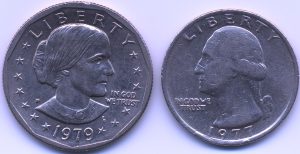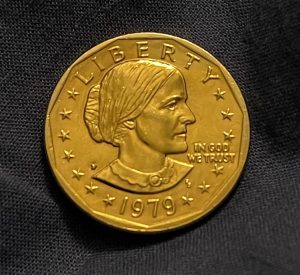I don’t know much about James Benfield, other than he was the director of the Coin Coalition until his death last month.
Since the late 1980s, the Coin Coalition was lobbying Congress for the introduction of a new dollar coin to replace the SBA; and for the elimination of the penny and the one dollar note.
Although I disagreed with their goal of eliminating the penny, I did support James’ efforts to introduce a new one dollar coin.
I’ve always been a fan of the one dollar coin, and back in the 1980s and the 1990s, I used to buy rolls of Susan B. Anthony dollars from banks to use for my daily spending cash. My aim was to do my small bit to increase general circulation of the coin.
I discovered that people didn’t like the SBA – and that, true to the rumor, it was often confused with a quarter. Although I liked the design of the coin, I did wish that it was gold colored with a smooth edge. It just made sense to me. The nickel and the penny had a smooth edge, establishing the rule that non-silver coins should have smooth edges. If the SBA were golden (as it should have been) then it should also have a smooth edge. But I liked the eleven-sided border design, the circle of stars, and even the portrait of Susan B. Anthony.

In an effort to reduce the amount of resistance that my SBA spending attempts were often met with, I taught myself how to do gold electroplating. I had learned copper electroplating in high-school science class, and I figured gold wouldn’t be that much different. For $24.00 I bought a quart of gold electroplating solution; then I bought some alligator clips and a cheap transformer from Radio Shack. I set up shop outside on my front porch in order to reduce my chances of being exposed to the toxic cyanide fumes.

Every weekend I would gold plate a roll or two worth of SBAs, roll them back up, and use them for my spending throughout the week. I knew that gold is a soft metal and that the plating would quickly wear off as the coin was handled. But my goal was just to get them out circulating and I figured even worn-off gold plating would make the coins distinctive.
These freshly-plated gold coins were accepted at every cash register without question, without hassle, and without even a blink. Even though no one had ever seen a golden dollar before, they instinctively knew what they were.
Oftentimes the coins were greeted with enthusiasm. I remember once leaving a gold-plated SBA in the upturned hat of a subway musician. I later saw him as he was going to remove his donations from his hat. He looked down and froze when he saw the coin. Then he slowly reached out, slowly closed his hand firmly around it, and paused, grasping it as if it was some sort of inconceivably priceless treasure.
My interactions with James Benfield were minimal and were mostly limited to a few telephone conversations. During one of these conversations, I told him what I had been doing with my gold plated Susan B. Anthony dollars. He asked me if I would be willing to send him some, so that he could show them to a few people around Congress.
I gladly sent him some, along with my thanks for his work; and his lobbying efforts were ultimately successful.
I have no idea if these gold-plated SBAs were any factor in the creation of the Sacagawea Golden Dollar. But I like to think that they were.

